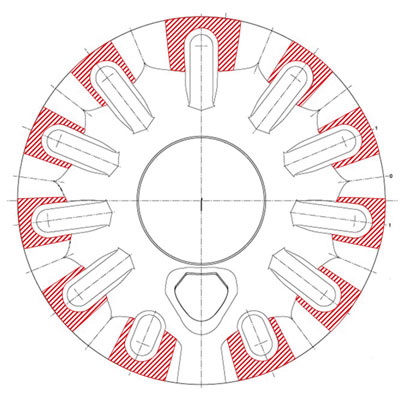Good news for operators of TPL-A and TPL-C turbochargers: Thanks to a newly designed turbine hood, casings do not necessarily have to be replaced even when their contact surfaces are found to be worn.
The turbine hood is an essential component of TPL-A and TPL-C turbochargers. It has two main functions: First, to protect the bearing casing from the high temperatures caused by the exhaust gases and, second, to guide the exhaust gas with minimum losses through the gas outlet casing.
The temperatures to which the turbine hood is exposed vary according to the operating mode of the engine. In addition to these, the hood must withstand sudden temperature drops caused by water impinging on its surface during turbine-side cleaning cycles.
The rotated wave shape in the new hood design has had the effect of changing the contact positions between the bearing casing, gas outlet casing and hood.
To allow for thermal expansion of the sheet metal, the turbine hood is clamped between the bearing casing and gas outlet casing (see figure below).
 Effective clamping is ensured by the hood’s wavy shape at its outer rim.
Effective clamping is ensured by the hood’s wavy shape at its outer rim.
 Standard turbine hood (Areas highlighted in red indicate the contact surfaces between the hood and gas outlet casing.)
Standard turbine hood (Areas highlighted in red indicate the contact surfaces between the hood and gas outlet casing.)
 New turbine hood; rotated wave shape
New turbine hood; rotated wave shape
- Effective clamping is ensured by the hood’s wavy shape at its outer rim.
- Standard turbine hood (Areas highlighted in red indicate the contact surfaces between the hood and gas outlet casing.)
- New turbine hood; rotated wave shape
The turbine hood is designed to ensure it remains properly clamped over the complete lifetime of the turbocharger. However, vibration, an increase in the number of load changes or turbine-side cleaning cycles can cause wear at the clamping shoulders of the bearing casing and the gas outlet casing. Increased wear causes a reduction in the clamping force, which could result in uncontrolled movement of the turbine hood.
To stop this happening, ABB service personnel always check the condition of the turbine hood and clamping shoulder during normal service activities. In situations where the field cartridge exchange is not performed by ABB, customers are asked to determine the wear at the gas outlet casing themselves and to provide the values to their closest ABB Service Station. Detailed measurement instructions can be obtained from every ABB Service Station.
When, in the past, the amount of wear on the clamping shoulders of the bearing casing and/or gas outlet casing was assessed to be too high, either one or both casings needed to be exchanged. To minimize maintenance costs for the customer ABB has now introduced a new turbine hood generation for all TPL-A and TPL-C turbochargers. The new version features a rotated wave shape at the outer rim (see Figs. 2 and 3 above).
The rotated wave shape in the new hood design has had the effect of changing the contact positions between the bearing casing, gas outlet casing and hood. Thanks to the design of the new turbine hood, operators will not necessarily have to replace casings even when their contact surfaces are found to be worn. Running costs can be kept lower as a result.














